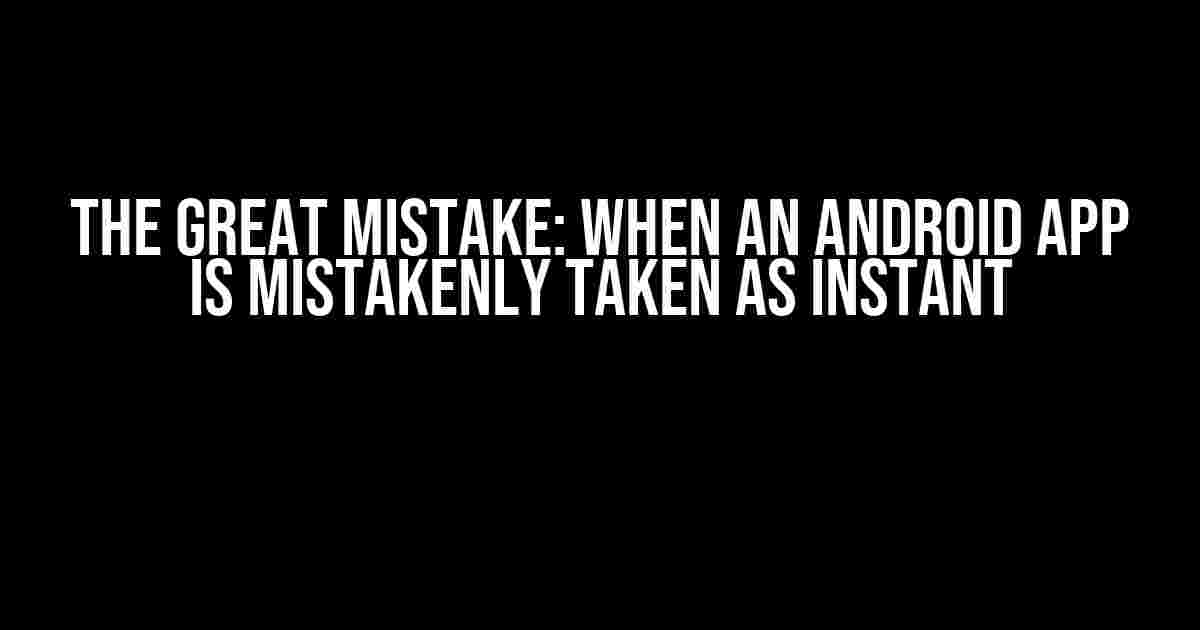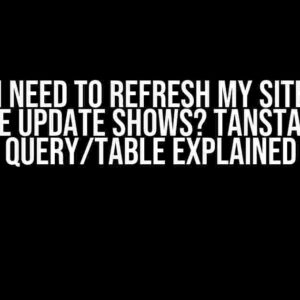Have you ever experienced the frustration of having your Android app mistaken as an instant app? You’re not alone! This phenomenon has been plaguing developers and users alike, causing confusion and disruption to the app ecosystem. In this article, we’ll delve into the world of Android apps and explore the reasons behind this mistake, as well as provide a step-by-step guide on how to prevent it from happening.
What is an Instant App?
An instant app is a type of Android app that allows users to try out a portion of the app without having to download and install it. This innovation was introduced by Google in 2017, aimed at providing a seamless user experience and increasing app engagement. Instant apps are typically smaller in size, ranging from 100KB to 4MB, making them easily accessible and fast to load.
The Benefits of Instant Apps
Instant apps offer several benefits, including:
- Faster user acquisition: Users can experience an app without having to download and install it, reducing the friction often associated with installing new apps.
- Increased engagement: Instant apps provide a seamless user experience, encouraging users to explore and engage with the app further.
- Better app discovery: Instant apps make it easier for users to discover new apps and try them out, increasing visibility for app developers.
Why is My Android App Mistakenly Taken as Instant?
There are several reasons why your Android app might be mistakenly taken as an instant app:
- Incorrect AndroidManifest.xml file: If your app’s AndroidManifest.xml file is not configured correctly, it may be mistaken as an instant app.
- Missing or incorrect intent filters: Instant apps use specific intent filters to define their capabilities. If your app is missing or has incorrect intent filters, it may be mistaken as an instant app.
- Inconsistent app package naming: If your app’s package name is not consistent across all platforms, it may cause confusion and lead to it being mistaken as an instant app.
How to Prevent Your Android App from Being Mistakenly Taken as Instant
Follow these steps to ensure your Android app is not mistakenly taken as an instant app:
Step 1: Review Your AndroidManifest.xml File
<manifest xmlns:android="http://schemas.android.com/apk/res/android"
package="com.example.myapp">
<application
android:allowBackup="true"
android:icon="@mipmap/ic_launcher"
android:label="@string/app_name"
android:supportsRtl="true"
android:theme="@style/AppTheme">
<activity
android:name=".MainActivity"
android:exported="true">
<intent-filter>
<action android:name="android.intent.action.MAIN" />
<category android:name="android.intent.category.LAUNCHER" />
</intent-filter>
</activity>
</application>
</manifest>
Verify that your AndroidManifest.xml file is correctly configured, with the necessary permissions, activities, and intent filters.
Step 2: Define Correct Intent Filters
Make sure your app defines the correct intent filters, specifying the actions and categories that your app can handle. For example:
<activity
android:name=".MainActivity"
android:exported="true">
<intent-filter>
<action android:name="android.intent.action.VIEW" />
<category android:name="android.intent.category.DEFAULT" />
<category android:name="android.intent.category.BROWSABLE" />
<data android:scheme="http" />
<data android:scheme="https" />
</intent-filter>
</activity>
Step 3: Ensure Consistent App Package Naming
Verify that your app’s package name is consistent across all platforms, including the Google Play Store, AndroidManifest.xml file, and other distribution channels.
| Platform | Package Name |
|---|---|
| Google Play Store | com.example.myapp |
| AndroidManifest.xml | com.example.myapp |
| Other Distribution Channels | com.example.myapp |
Conclusion
In conclusion, having your Android app mistakenly taken as an instant app can be frustrating and disrupt the user experience. By reviewing your AndroidManifest.xml file, defining correct intent filters, and ensuring consistent app package naming, you can prevent this mistake from occurring. Remember, a well-configured app is essential for providing a seamless user experience and increasing engagement. Don’t let your app be mistaken as an instant app – follow these steps and ensure your app is recognized for what it is – a unique and valuable experience for your users!
By following these guidelines, you’ll be able to avoid the common pitfalls that lead to your Android app being mistakenly taken as an instant app. Remember to stay vigilant and monitor your app’s performance to ensure it’s providing the best possible experience for your users.
FAQs
Frequently asked questions about Android apps being mistakenly taken as instant apps:
Q: What is the main difference between an instant app and a regular Android app?
A: Instant apps are smaller in size, typically ranging from 100KB to 4MB, and provide a seamless user experience without requiring installation. Regular Android apps, on the other hand, require installation and can be of any size.
Q: Can I convert my regular Android app to an instant app?
A: Yes, you can convert your regular Android app to an instant app by following the guidelines provided by Google and optimizing your app for instant experiences.
Q: Will my app be affected if it’s mistakenly taken as an instant app?
A: Yes, if your app is mistakenly taken as an instant app, it may lead to confusion and disruption to the user experience. It’s essential to ensure your app is correctly configured to avoid this mistake.
By understanding the differences between instant apps and regular Android apps, and following the guidelines outlined in this article, you can ensure your app provides the best possible experience for your users and avoids common mistakes that can lead to confusion and disruption.
Frequently Asked Question
Get the clarity you need about Android apps mistakenly taken as instant apps.
What happens when an Android app is mistakenly taken as an instant app?
When an Android app is mistakenly identified as an instant app, it can lead to issues with app functionality, such as restricted access to certain features, and even impact app performance. In some cases, users might experience crashes or errors while using the app.
How do I know if my Android app has been mistakenly taken as an instant app?
To identify if your Android app has been mistakenly taken as an instant app, check for unusual behavior, such as limitations in app functionality, or errors when trying to access certain features. You can also review your app’s package name and manifest file to ensure they haven’t been mistakenly marked as an instant app.
What are the common reasons why an Android app is mistakenly taken as an instant app?
Common reasons include incorrect package naming, incorrect manifest file configuration, or mistakes during the app development and publishing process. Sometimes, even a simple typo in the app’s configuration files can lead to this issue.
How can I fix my Android app if it’s been mistakenly taken as an instant app?
To fix the issue, review your app’s configuration files, package name, and manifest file to identify and correct any mistakes. Ensure that your app is correctly configured and published as a regular Android app, not an instant app. If the issue persists, consider reaching out to Google Play Store support for further assistance.
Can I prevent my Android app from being mistakenly taken as an instant app in the future?
Yes, you can take preventative measures by double-checking your app’s configuration files, package name, and manifest file for accuracy before publishing. Regularly review your app’s performance and functionality to catch any potential issues early on. Additionally, stay up-to-date with the latest Android app development guidelines and best practices to avoid common mistakes.



